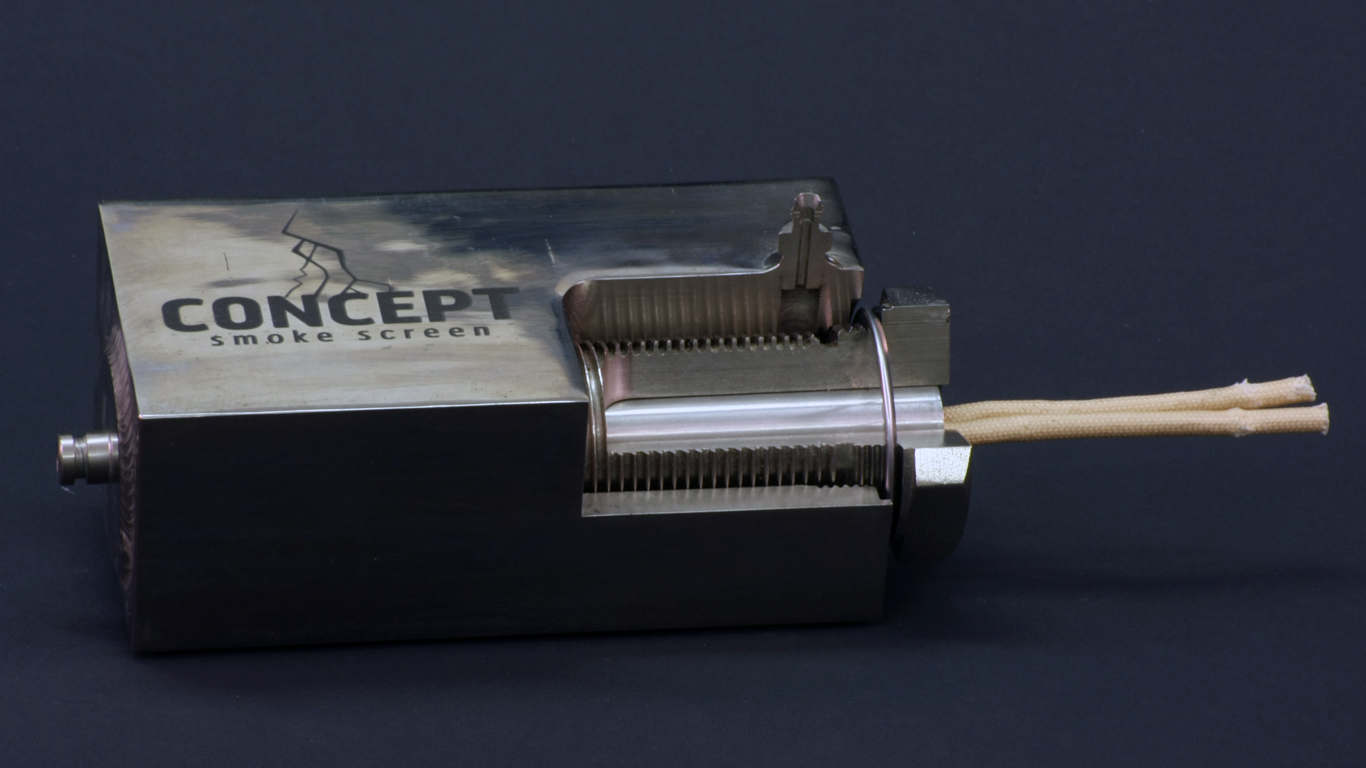Particle Size & Settling Velocities
Why small is beautiful?
Common to all Concept standard smoke generators is our incorporation of precision machined, specially treated steel heat exchanger blocks, in which the smoke fluid is vaporised.
Particle Settling Velocity
The terminal settling velocity of an aerosol or “artificial smoke” particle increases rapidly with particle size. The settling velocity is proportional to the square of the particle diameter, although submicron particles, such as those produced by Concept systems require the use of slip correction factors.
At the heart of all Concept mains powered smoke generators is a heat exchanger block which is machined to tolerances that are measured in microns. This approach results in a consistency of smoke quality and smoke particle size that is unmatched by other manufacturers.
That may seem academic, but if you take the adjacent picture as an example, if the particle on the right was a 0.2 micron Concept particle, the one on the left would be just over 1.5 micron diameter. That’s fairly typical of our competition, who generally produce fog particles 1–5 micron diameter using cast or platen type heat exchangers.
This compares with a typical particle size of just 0.2-0.3 micron mmd for the vast majority of our smoke systems, be they water or oil-based.
The general benefits of producing such a consistent and clearly defined particle distribution are:
- the smaller the particle size of the smoke, (or more accurately fog) the smaller the amount of chemical is required within the atmosphere to achieve any given visibility. This can have a significant effect on running costs for heavy users of artificial smoke (fire brigades etc.)
- the less the amount of chemical in the atmosphere, the safer the smoke if measured in terms of relative Occupational Exposure Levels.
- the smaller the particle size of the smoke, the lower its settling velocity (the rate at which a particle will fall, due to gravity). A smoke particle of unit density, 0.2 microns in diameter, will fall at 8mm /hr, compared to a 2-micron particle, which falls at 468mm/hr. In essence, this means that the smaller the particle of smoke you produce, the less chance there is that deposition of smoke particles will occur.
Concept’s expertise in our field means that we actually produce systems specifically designed to fulfill the requirements of BS 5295/EN-ISO 14644-3 Section C.6.3, for the testing of HEPA filters in the nuclear, chemical, and pharmaceutical industries Concept also have personnel registered with the National Radiological Protection Board (NRPB) for site work at nuclear establishments.
| Particle Diameter (µm) | Settling Velocity (m/s) | Settling Velocity (mm/hr) |
| 0.05 | 3.85E-07 | 1.39 |
| 0.06 | 4.75E-07 | 1.71 |
| 0.08 | 6.69E-07 | 2.41 |
| 0.1 | 8.82E-07 | 3.18 |
| 0.15 | 1.50E-06 | 5.40 |
| 0.2 | 2.26E-06 | 8.14 |
| Typical Concept particle | ||
| 0.3 | 4.21E-06 | 15.16 |
| 0.4 | 6.76E-06 | 24.34 |
| 0.5 | 9.91E-06 | 35.68 |
| 0.6 | 1.37E-05 | 49.32 |
| 0.8 | 2.30E-05 | 82.80 |
| 1 | 3.48E-05 | 125.28 |
| 1.5 | 7.47E-05 | 268.92 |
| 2 | 1.30E-04 | 468.00 |
| 3 | 2.85E-04 | 1026.00 |
| 4 | 5.00E-04 | 1800.00 |
| 5 | 7.76E-04 | 2793.60 |
| Typical competitor particle size | ||
| 6 | 1.11E-03 | 3996.00 |
| 8 | 1.96E-03 | 7056.00 |
| 10 | 3.06E-03 | 11016.00 |
| 15 | 6.84E-03 | 24624.00 |
| 20 | 1.21E-02 | 43560.00 |
| 30 | 2.72E-02 | 97920.00 |
Calculated for standard density spheres at 293 K [20° C] and 101 kPa (1 atm). “Aerosol Technology”, William C. Hinds, Wiley-Interscience, 1999.
Require more information?
Please get in touch if you’d like to discuss any technical queries, or provide advice or simply require more information.





